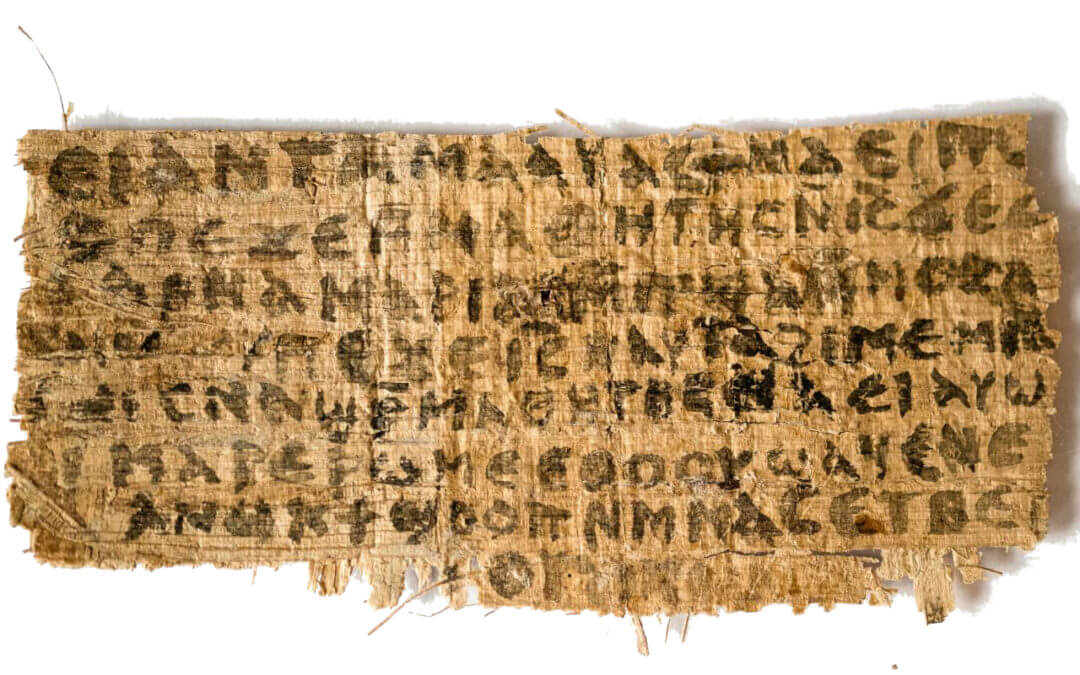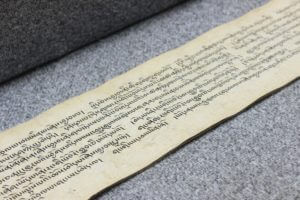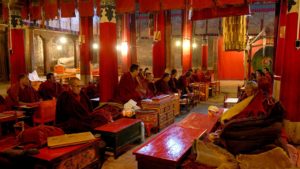
A comparison of the so-called Gospel of Jesus’ wife and the Unknown life of Jesus Christ/ Issa.
Image Public Domain Wikicommons
A Controversial Fragment
Since its announcement in 2012, there has been a lot of controversy about what is known as the Jesus Wife Papyrus otherwise known as the Gospel of Jesus’ wife.This is a small fragment of text written in the Coptic language that has been examined by a leading scholar from Harvard University, Professor Karen King and her colleagues.
After Professor King announced the existence of the papyrus accusations of forgery quickly followed seemingly due to the contents of the fragment. It appears to feature Jesus saying the words, ‘my wife’.
Professor King is a respected Harvard scholar with a long standing reputation. Before the announcement she had already done some initial investigation and satisfied herself that this was an authentic manuscript, but still the accusations came.
Jesus had a wife?
For Jesus to mention a wife is so abhorrent to some people that they will perhaps always claim it is a forgery. Noticeably these same people do not denigrate every little fragment of the Gospel of Mark or John, presumably because the contents do not offend them in those cases.
Professor Karen King has always been careful to point out that this text does not mean that Jesus was married: just that some early Christians might have thought he was.
After the media frenzy and some further investigation by the likes of MIT scientists, a scholarly publication concluded that the papyrus and the ink were both ancient. Yet still the debate is raging with many still insisting that the fragment is a modern forgery.
In praise of the feminine
In my opinion, as an outsider to Biblical scholarship, there seems to be more debate about this piece of Coptic script than a lot of other pieces of Coptic script. Maybe because the actual text is saying something that many people just do not believe Jesus could have uttered – he praises women and perhaps even refers to someone who is his wife.
The full translation is as follows from both the front and the back of the fragment.
Translation
1 ] “not [to] me. My mother gave me li[fe…” 2 ] .” The disciples said to Jesus, “.[
3 ] deny. Mary is [not?]worthy of it [
4 ]…” Jesus said to them, “My wife . .[
5 ]… she is able to be my disciple . . [
6 ] . Let wicked people swell up … [
3
7] . As for me, I am with her
3 in order to . [ 8 ] . an image … [
] my moth[er ] thr[ee
] …[
] forth …[
] (untranslatable) [
This is the translated text in full which is taken from the front and back of this tiny credit card sized fragment. Of course it is just a fragment and there are lots of gaps, but it is mainly the line, ‘Jesus said to them “my wife..”‘ that is causing the controversy.
Comparison of other texts
But if we look more closely, this does fit with other texts that we know of. For example in this fragment, Jesus discusses whether a woman is able to be his disciple. This has parallels with some other non-canonical texts such as the Gospel of Phillip in which there are arguments about whether or not Mary Magdalene was fit to receive teaching from Jesus due to her being a woman.
What drew my attention were the first lines “My mother gave me life” which precedes a passage seeming to praise woman including the phrase “as for me, I am with her”.
A forgotten gospel
This passage seemingly praising the virtues of women reminded me of something called the Tibetan Gospel of Issa. Nowadays this text is pretty much forgotten but about one hundred years ago ‘The Unknown Life of Jesus Christ’ by Nicolai Notovitch caused a bit of a sensation.
Notovitch was an adventurer and writer. Born in 1858 in the Crimea, he was educated at the University of St Petersburg after serving in the Russian-Turkish war as an Officer.
An epic journey
Apparently in 1887 he travelled to Tibet and Kashmir. During his travels he broke his leg which needed an extended stay in a monastery in Tibet. Whilst he was convalescing, apparently the Buddhist monks allowed him to see and to translate some secret writings that revealed the life of a saint they called Issa. Notovitch took this to mean Jesus Christ.
On this return to the West he published this secret Gospel and it caused a sensation. Nowadays most people think this gospel is a fake and even question if Notovitch was ever in Tibet.
I find this latter point a bit odd as his book, which is readily available as an ebook, provides a vivid account of his travels in India, Nepal and Tibet and is littered with details. Descriptions of roads, people, vehicles and mountain views abound in his account. Indeed his travelog actually takes up a good deal of the book before the ‘gospel’ even starts.
Most people will probably never even attempt to read the book. It is generally believed to be a fake so when those sorts of rumours are in abundance, people don’t even bother investigating something for fear of wasting their time or worse, of looking gullible and foolish. This is irrespective of whether it is truly fake or not. Even if the travelog part is genuine, it is still uncertain as to whether this newly discovered ‘gospel’ is authentic.
Similarities or synchronicities?
However I did find it interesting that the Gospel of Jesus’ wife or Jesus wife papyrus echoes some of the passages of the sayings of Issa. Such as,
Respect woman for in her we see the mother of the universe and all the truth of divine creation is to come through her…She is also the germ of life and death.
Again this is at the start of a long passage of respecting mothers, women and wives as the source of a man’s divinity on earth.
Even as the Lords of Hosts separated the light from the darkness and the dry land from the waters so does woman posses the divine gift…
In my opinion here are parallels between the Lost Gospel of Issa and the Gospel of Jesus wife. Both texts demonstrate respect for women which Jesus was known for in his teaching. This veneration of women was out of keeping for the time of Jesus and also for the Victorian era in which Notovitch was publishing although it was less of a stretch.
Certain other elements of the texts bring into question whether this is a Victorian fabrication. The Gospel of Issa features an account of the missing years of Issa/Jesus which it says he spent in India. There he was taught the Vedas and other holy scriptures.
Issa the Rebel
The character of Issa doesn’t like the fact that the holy teachings are kept away from the lower castes of India and decided that all people were created equal so started to spread the teachings.
He also ignored the teachings about the many gods of Hinduism preferring to teach that god is the indivisible soul of the universe. These actions of Issa eventually annoy the Hindu priests as they feel that he is disrupting the social order by teaching the lower castes.
The priests decided to send people to kill him, but Issa escaped and headed for the Himalayas for further study. As the text moves on, Issa almost gets into trouble again with teachers in another area before escaping back to Israel at the age of 29 where eventually he is tried by Pilate. These latter details were purportedly provided by merchants traveling between Palestine and India.
During the text there is a repeated doctrine that God is a formless creator and that idols should not be worshipped. It is hard to say if these texts were made up by Notovich. It is reassuring that he himself wrote a critique of the texts and the contradictions they contain.
Jesus in India and Universal Truths
There is a very strong tradition that Jesus spent some of his missing years in India and Tibet. People have also noticed the similarities between the teachings of Jesus and those of Buddhism in places and have suggested that these have arisen due to Jesus’ missing years having been spent in India. Conversely in the canonical Gospels, at times, Jesus seems adamant that people should follow Jewish laws.
In my opinion Buddhism and Christianity like all religions include some universal truths which mystics have access to no matter the era. So the similarities between Christianity and Buddhism could be less to do with a possible sojourn of Jesus in India and more to do with the fact that these are universal truths.
Now that the materials involved in the fragments of the Jesus Wife Papyrus have been authenticated, I do find it interesting that there are similarities of between the Jesus wife papyrus and the supposed missing gospel of Issa from Tibet. Because the materials of the fragment of papyrus have been authenticated as being ancient, this may be time to revisit the Issa text as there are some similarities with these lost early Christian beliefs.





